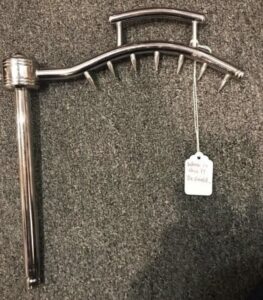Uncovering the Historic Mystery of an Antique Culinary Tool
Discovering an unknown item in an antique shop is similar to discovering a hidden gem. It piques interest and inspires a detective-like pursuit to learn more about its history and intent. Such an encounter was recently had by customers and employees at an antique store in Maryland when they discovered an odd metal spiky object. Wearing a sticker that openly acknowledged, “What is this!?”, this enigmatic object became the focus of curiosity and conjecture.
The purpose of this metal device was initially unclear without the context of the cutting board that came with it. Its design was both fascinating and perplexing, with jagged metal spikes organized as though they were intended to secure something. Even the employees of the antique store were baffled by its purpose, which was further obscured by the missing cutting board, an essential part of its operation.
An Exploration Journey
Thankfully, the strength of group knowledge—especially from a Reddit online community—came into play. The object was ultimately determined to be a roast or ham holder that was meant to be mounted to a cutting board with the assistance of this community. Unfortunately, there was no cutting board.

This discovery sheds light on the intriguing realm of culinary antiquities and the historical development of kitchen appliances. Large slices of meat were the focal point of meals and entertainment at the period, thus these roast or ham holders were made with convenience and functionality in mind. These holders made carving easier by securing the meat to a cutting board, enabling more accurate and sophisticated table presentation.
Reminiscent of a Craftsmanship Era
The roast holder’s design, which features spikes to securely hold the meat, is reminiscent of a time when kitchenware was made with efficiency and durability in mind in addition to practicality. This kitchen set would have been complete with the missing cutting board, which was probably constructed of wood. It would have given the holder a sturdy base and shielded the table or countertop from scratches and damage while the carving was being done.
The Influence of Virtual Communities
This process of discovery—from a mysterious metal object to a kitchen tool with a particular purpose—illustrates the important role that internet communities play in unraveling historical mysteries. People with different hobbies and areas of expertise come together on sites like Reddit to develop a collective intelligence that can solve historical mysteries. In this instance, collective knowledge not only assisted in recognizing the item but also in recognizing how inventively earlier generations had developed instruments to make daily chores easier.
A Look Back at Culinary History
Furthermore, the tale of the ham or roast holder demonstrates the appeal of vintage buying. Every object has a backstory that is just waiting to be discovered. Because they provide insights into the cultural and social practices of the past, it serves as a reminder of the value of conserving and comprehending the objects of daily life.
For anyone interested in culinary history, these objects offer a glimpse into how cooking and dining practices have changed throughout time, reflecting shifts in taste, technology, and lifestyle.
In conclusion, the metal spiky instrument, which at first caused uncertainty and interest at an antique store in Maryland, demonstrates the development of cooking equipment and the rich tapestry of culinary history. The fact that it is identified as a roast or ham holder and is made to mount to a cutting board emphasizes how important local knowledge is for solving historical puzzles.
In addition to enhancing our knowledge of historical cooking customs, this finding honors the spirit of adventure and the never-ending pursuit of knowledge about the items that have been used by generations before us.


